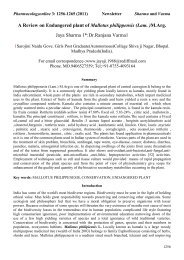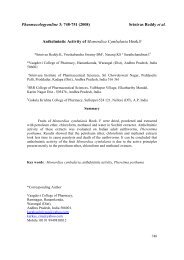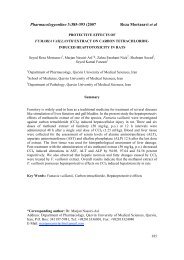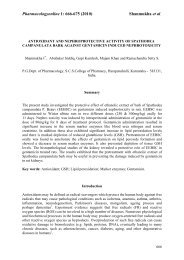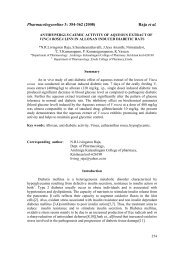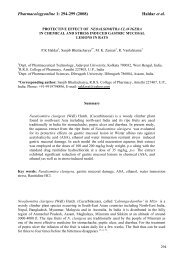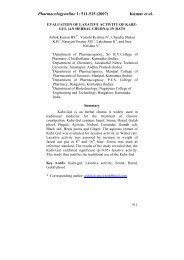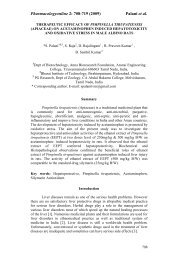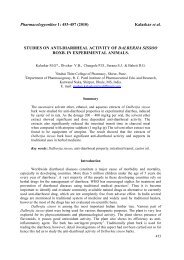Effect on capillary permeability in rabbits of Acalypha
Effect on capillary permeability in rabbits of Acalypha
Effect on capillary permeability in rabbits of Acalypha
Create successful ePaper yourself
Turn your PDF publications into a flip-book with our unique Google optimized e-Paper software.
Pharmacoloy<strong>on</strong>l<strong>in</strong>e 1: 113-119 (2006) Pérez Gutiérrez and Vargas Solìs<br />
more pr<strong>on</strong>ounced at 250 mg/kg (90.2% reducti<strong>on</strong>). The protective microvascular activity <strong>of</strong><br />
B. scordioides, is shown <strong>in</strong> the Table 2.<br />
Table 1. <str<strong>on</strong>g>Effect</str<strong>on</strong>g> <strong>of</strong> the aqueous extract <strong>of</strong> <strong>Acalypha</strong> lang<strong>in</strong>ia <strong>on</strong> <strong>in</strong>creased microvascular<br />
<strong>permeability</strong> <strong>in</strong>duced by both chlor<strong>of</strong>orm and histam<strong>in</strong>e <strong>in</strong> <strong>rabbits</strong>.<br />
Treatment mg/kg Inhibiti<strong>on</strong> (%)<br />
0.9% NaCl 0<br />
25 10.1<br />
100 61.5<br />
150 73.2<br />
200 81.4<br />
250 90.2<br />
Troxerut<strong>in</strong> 25 45.9<br />
Table 2. <str<strong>on</strong>g>Effect</str<strong>on</strong>g> <strong>of</strong> the aqueous extract <strong>of</strong> Buddleia scordioides, <strong>on</strong> <strong>in</strong>creased microvascular<br />
<strong>permeability</strong> <strong>in</strong>duced by both chlor<strong>of</strong>orm and histam<strong>in</strong>e <strong>in</strong> <strong>rabbits</strong>.<br />
Treatment mg/kg Inhibiti<strong>on</strong> (%)<br />
0.9% NaCl 0<br />
25 0<br />
100 23.1<br />
150 27.8<br />
200 31.5<br />
250 37.3<br />
Troxerut<strong>in</strong> 25 45.6<br />
The group treated with 250 mg/kg <strong>of</strong> extract showed 37.3% reducti<strong>on</strong>. A results <strong>of</strong> the<br />
effects <strong>of</strong> extract <strong>of</strong> H. undatus <strong>in</strong> <strong>rabbits</strong> are shown <strong>in</strong> Table 3. The extract produced a<br />
maximum <strong>in</strong>hibiti<strong>on</strong> at 250 mg/kg <strong>of</strong> 43.5%. The adm<strong>in</strong>istrati<strong>on</strong> <strong>of</strong> 200 mg/kg <strong>of</strong> T. stans<br />
(Table 4) produced a significant <strong>in</strong>hibiti<strong>on</strong> <strong>of</strong> 58.1% and caused a maximum <strong>in</strong>hibiti<strong>on</strong> at a<br />
dose <strong>of</strong> 250 mg/kg (69.3%). The group treated with 250 mg/kg <strong>of</strong> extract <strong>of</strong> A. vim<strong>in</strong>alis<br />
showed <strong>on</strong>ly a 12.6% <strong>in</strong>hibiti<strong>on</strong> (Table 5).<br />
117



